As of October 7th, Ravnica: City of Guilds is eighteen years old–meaning it came out at essentially the midpoint of my life so far. That hardly seems fair to me, particularly given the clarity with which I can recall its release. I remember going to the Prerelease, groggy and out-of-sorts because I had stayed up until 3 a.m. the night before with a friend trying to beat Jack Krauser in Resident Evil 4. Weeks before, we had seen Helldozer previewed on a commercial bump on [adultswim]–how’s that for a time capsule?–and excitement was running high in the Durham convention center. I had turned nineteen the month before, the age most prone to obsession, and I was obsessed with Magic–a one-sided relationship, as recently Magic hadn’t been worth obsessing about.
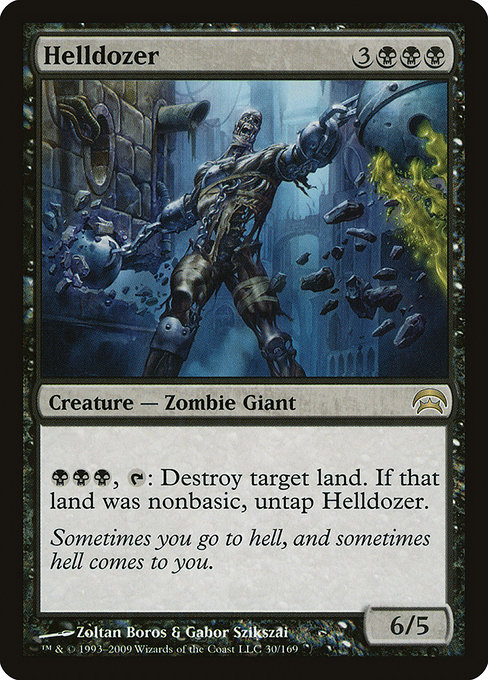
The generally-accepted history is that Magic, in 2005, was in big trouble–like a lot of generally-accepted history, this lacks nuance but is broadly correct. At the time, Magic was in the same exact situation it was five years previous–the absurdly broken Urza’s block led to a demoralizing powering down in Masques block, followed by a renaissance in the multicolored-focused Invasion. From 2003 to 2005, we had repeated that exact trajectory: the artifact hell of Mirrodin had transitioned to the clunky and parasitic Kamigawa block, and tournament attendance and casual excitement had suffered.
Mirrodin was not quite as broken as Urza’s block–or was broken in different ways–and Kamigawa was more interesting than Masques block, but we still needed a savior, and for the same reasons. As with Invasion, Wizards broke the glass on a multicolored set. Onslaught block had one (awful) multicolored card in Karona, Mirrodin block had zero multicolored cards, Kamigawa block a scant two (Genju of the Realms and Iname as One)–unimaginable from our vantage point of 2023, with uncommon cycles of every color pair in almost every set and the dominance of Commander, but that’s how multicolored was employed back around the new millennium.
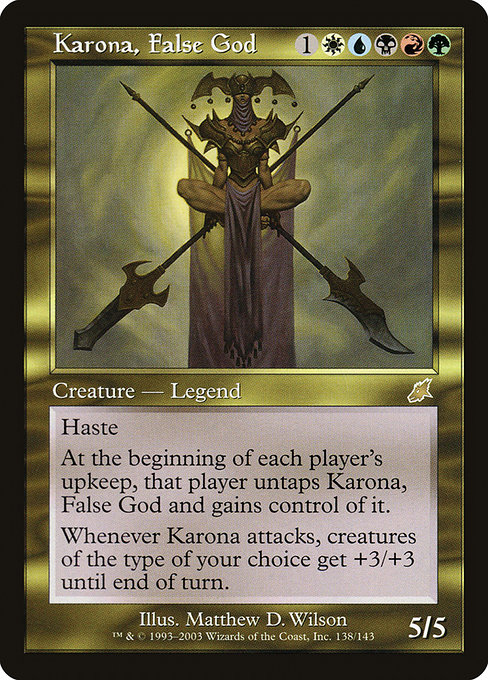
In his contemporary articles, Mark Rosewater notes that “multicolored” was the most popular “theme” in player surveys–it’s wild to me that Wizards took that data point and decided that multicolored was best held in reserve for an all-multicolored blowout like Invasion and Ravnica instead of included in every set. Generally speaking, if your job is to deliver a creative product, and consumer feedback is that they love Aspect X of your product, you should probably commit to delivering as much Aspect X as possible instead of withholding it. Regardless, Ravnica heralded a new philosophy, one that ended the drought of multicolored cards with a deluge.
Ravnica has a profound elegance. It was the set that defined what each color pair could do–Invasion was a definition of what each color pair cared about, while Ravnica was an exploration of what each color means. It’s a subtle but distinct difference, the difference between knowing the definition of a word versus knowing its etymology, the difference between enjoying a dish versus knowing how to prepare it from scratch. Invasion gave us cards like Heroes’ Reunion and Noble Panther–exploring the shared territories of each color combination, powered up by the difficulty of requiring multiple colors–while Ravnica gave us cards like Glare of Subduali and Shadow of Doubt, which are philosophical instead of practical.
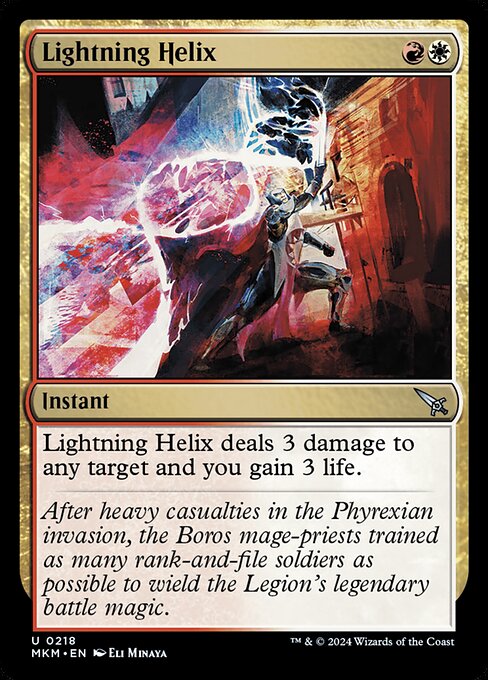
Jesse Mason, of Killing a Goldfish, one of the best (albeit abandoned) blogs on Magic design, suggests Ravnica’s success comes from the fact that “Magic found a story that only it could tell.” He’s right. Ravnica cemented what each color pair could do and branded each with terminology we still use two decades later. People want easy labels to apply to themselves, from astrology to enneagrams to Buzzfeed quizzes, and Ravnica let us do so within the context of Magic–letting us infuse our identity into the creative structure of the game. It’s brilliant; by giving us an identity within Magic, you foster investment that goes far beyond, “These are the best cards or the cards I like to play.”
Lightning Helix suddenly isn’t just a premier removal spell, but a spell in your Boros toolbox–when you cast it, you’re not just playing a game, but making your guild proud. Now imagine you’re first seeing Helix after years of Shock and Electrostatic Bolt as your baseline for playable burn. Suddenly, after two years of Affinity and Heartbeat mirrors, of having your dreams crushed by whoever first-picked Loxodon Warhammer or Umezawa’s Jitte, Wizards gave us the tools to play whatever we wanted. It wasn’t just an exciting time to play Magic, but an exciting time to love Magic.
[Editor’s Note: I would like to just interject that the author may be looking back on the Kamigawa-Ninth Edition-Ravnica Standard with somewhat rose-tinted glasses. This editor recalls playing a deck that would Boomerang your first land, Remand your first spell, and then proceed to win with Howling Mine and Ebony Owl Netsuke. Not every match was suddenly “fun” or more fun than Heartbeat of Spring match-ups.]
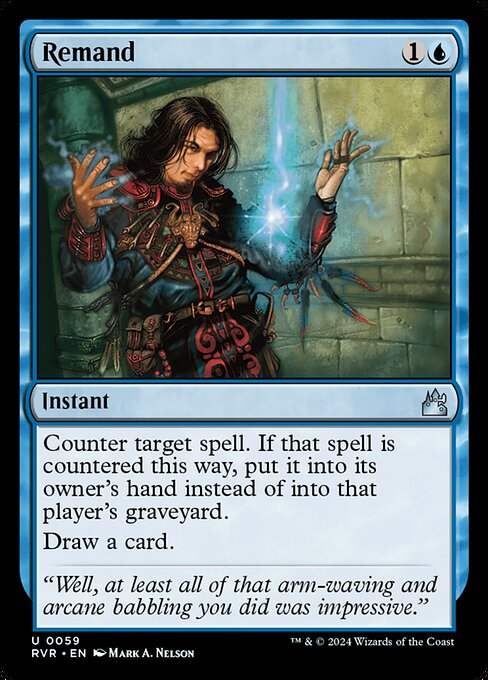
Ravnica, after the b-tier comic book style of Mirrodin and the bizarre fantasia of Kamigawa, was also creatively brilliant–a Gothic world of cathedrals and street fairs, a concrete and considered world. The characters had occupations beyond “wizard” or “warlord” and the guilds all served an economic or ecological niche, all leading to a believable world. It was still a world of dangers and horrors, as suggested by cards like Carrion Howler and Infectious Host, but it was also a world of commerce and whimsy, as we see on Hammerfist Giant and Tin-Street Hooligan. Ravnica is perilous, but, at least in its initial appearance, it wasn’t imperiled.
Creatively, Magic was reeling–Mirrodin was the first time we’d fully left Dominaria behind, with only brief sojourns to very traditional fantasy worlds like Rath and Mercadia, and it was a shock to land on a sci-fi world of robots and vedalken. Mirrodin was followed up by Kamigawa, which was a big creative swing that was more Kwaidan than kawaii–with Ravnica, we returned to a more familiar world of Vampires and Elves. They might haunt cathedrals instead of castles, but there were fewer floating eyeballs and Wandering Ones (which may be a downgrade, depending on your aesthetic preferences). Ravnica wasn’t creatively safe–forcing players to learn the names and philosophies of ten guilds could never be considered safe–but it was more familiar territory, both creatively and ludically. Ravnica innovated, but it innovated off of the common benchmarks we had come to expect: Watchwolf was Savannah Lions plus Norwood Ranger, Lightning Helix was Lightning Bolt plus half of Healing Salve, Seeds of Strength was a hybrid of Giant Growth and Warrior’s Honor. Char was a color-shifted Psionic Blast, Moroii put a spin on Air Elemental, etc. After the rocky introduction of Equipment, the Legendary rule issues with Kamigawa, the failure of Arcane spells, and the profoundly misjudged Affinity, Ravnica felt like a back-to-basics moment, with familiar markers to guide us into a new era of Magic design.
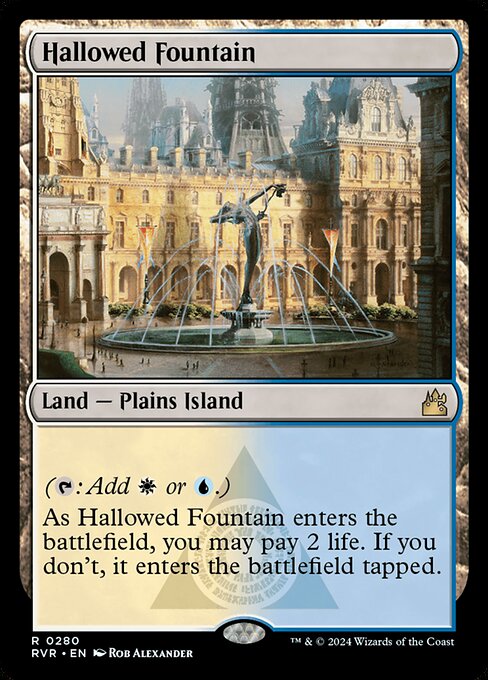
Obviously, Ravnica’s greatest innovation was the guild pairings and the attendant cycles granted to each–the shocklands (Sacred Foundry), the Signets (Azorius Signet), and the bouncelands (Simic Growth Chamber). But I maintain that EDH would not have become Commander without Ravnica: the block gave us twenty new dual-colored Legendary Creatures right as the format was kindling. Fetchlands would have been used to fetch duals in Legacy and basics in Extended, and not to enable decks that have gone to define almost two decades of Magic. Ravnica wasn’t an evolution–it was a reinvention. So in the spirit of revisiting our old Stomping Grounds, I want to highlight the importance of cards that were heralded eighteen years ago, but might not be familiar to the new generations of players who have come since, whose reference point might be Voice of Resurgence instead of Watchwolf.
Angel of Despair
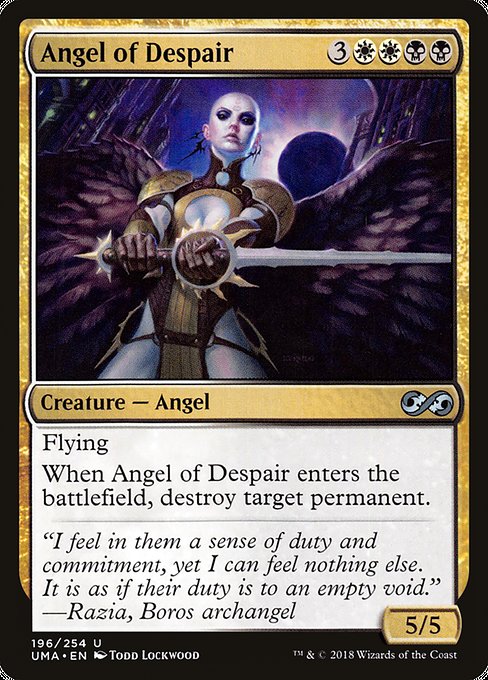
Angel of Despair: One of the luminaries of Guildpact, Angel of Despair tacked a Vindicate onto a game-winning threat. Since we were trained to expect Vindicate at 1WB, the extra 3WB for a 5/5 flier felt like a bargain. In a world of Ashen Rider and Archon of Despair, the Angel is quaint at best, but at the time, it was one of the best threats to reanimate and the genesis of the Ravnica Standard Solar Flare deck, an incredibly fun deck archetype that saw continued development in Innistrad block. It was a safe design, tacking tournament darling Vindicate onto casual darling “big angel,” but it also felt transgressive–there had only been Selenia, Dark Angel and Desolation Angel as White/Black Angels, and it felt like a statement of purpose for the perverse Orzhov.
Giant Solifuge
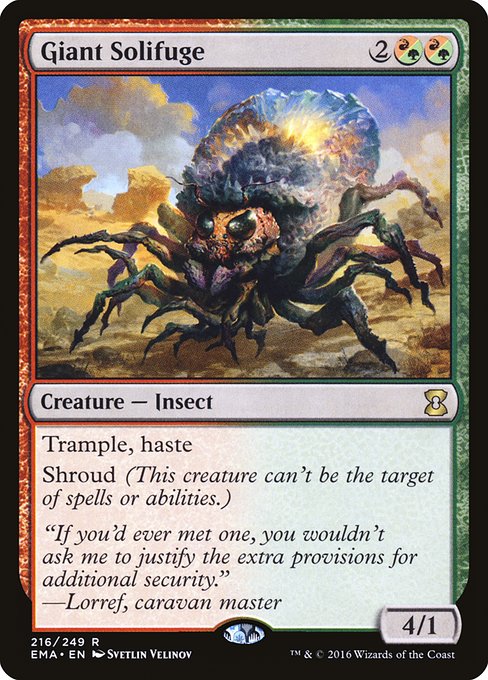
Giant Solifuge: Mark Herberholz’s “Heezy Street” deck landed like a warhead. The best existing source for the decklist is a pretty snide old Mike Flores piece, but it’s a good snapshot of where the format was at the inception of Guildpact, back in an era where Ravenous Rats and Meloku, the Clouded Mirror were threats. Giant Solifuge isn’t impressive in 2023, but neither is the Apple II–doesn’t mean it wasn’t a massive upgrade in its era. Ravnica was a one-for-one interactive format, and one of the healthiest in the game’s history at that point–Solifuge refuses to let you interact with it, and thus was a serious predator. Your best bet was to cast Cruel Edict and hope they didn’t have a spare Elf lying around.
Remand

Remand: Ravnica debuted some extremely exciting cards–Watchwolf, Lightning Helix–but it also brought cards that I completely misjudged. Remand was one of those–it reads like a minor nuisance, a Memory Lapse variant, but, as contemporary players often referred to it, it plays closer to Time Walk. As a permanent counter spell, it’s lacking–as a tempo spell, though, it excels, particularly when backed up by other counterspells. At one point a Modern staple, Remand has languished in a world of free counters and pitch Elementals, but, like Brainstorm before it, it was one of those deceptive Blue Instants that you could write a thesis about.
Grave-Shell Scarab
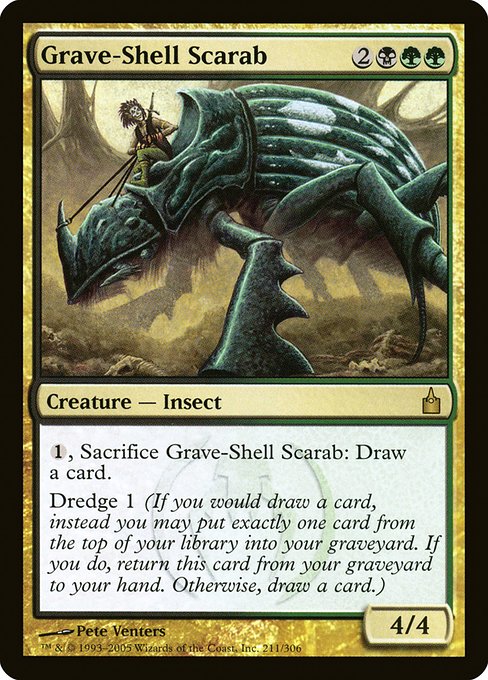
Grave-Shell Scarab: This card jumpstarted my love affair with Golgari. I was on the cusp, having just come down from the joys of Ravenous Baloth plus Oversold Cemetery plus Undead Gladiator, but this was the card that clinched the deal. Ironically, when first previewed, it was the minimal Dredge number that had players excited–the Scarab would end up seeing very little play, as Dredge wasn’t a way to buy back your dead cards, but a way to mill yourself.
A tournament striver and ‘netizen named John “Friggin” Rizzo took one look at Dredge and, with the inspiration and dedication of a true artist, decided to snap it in half. Over the course of several months and thousands of words, Rizzo taught us how to dump our entire libraries in our graveyards, counteract opposing copies of Ichorid with Crypt Keeper Creeper, and learn to love milling ourselves for beats. I can’t recommend tracking down those old articles these days, as they’re undiluted nu-misogynist logorrhea or impenetrable thickets of aughts Magic jargon, but JFR took a mechanic Wizards created to help players and warped it into a twisted parody of itself. It’s the true beauty of the tournament player mindset.
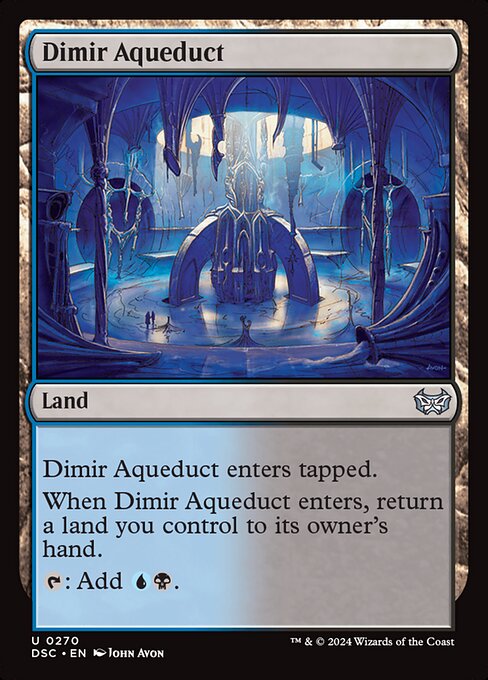
For Limited, Ravnica’s second-best quality was the fixing–the bouncelands and the Signets at common meant a common–and successful–strategy was to take the fixing first, and then pick whatever bombs floated your way, secure in the knowledge that you could always cast them. This would later be honed during Shards of Alara block, but Ravnica set the precedent after Invasion’s clunkier mana fixing. Early on, pro players sneered at “taking turn two off” to land a bounceland or a Signet, and indeed, sometimes you were punished for it with a grip full of bouncelands on turn one or an opponent’s Scab-Clan Mauler, but they soon adopted the strategy once they saw its yield. Unlike later Ravnican cycles–e.g., the Cluestones and the Gates–the Signets came down early and could be used immediately, to the extent they saw adoption in Standard.
Ravnica Limited’s best quality was what that fixing enabled. Aside from the bombs–the rare guild Legendary Creatures, the Rumbling Slums, etc.–the removal was vastly better than we’d come to expect. Putrefy, Electrolyze, Last Gasp, Lightning Helix, Mortify, Cackling Flames–there a dozen or so first-pick-caliber removal spells after a dearth of playable removal. There’s a reason I’m excited for Ravnica Remastered–simply taking the best mana fixing and best removal from those nine sets is a decent start to a low-powered Cube, so I’m anticipating a great Limited format.
In another eighteen years, I’ll be 55, and Magic will be 48. My daughter will be the same age I was when Ravnica released. I won’t feel the same nostalgia opening a borderless anime alt-art Savra, Queen of the Golgari, my first real Commander, but I’ll still be opening packs of Ravnica Remastered. There’s no telling what 2041 will look like for Magic, or for me, and no guarantees–but if I’m still around, and if Magic is still around, I’ll be there, opening packs of Eldraine Remastered and commiserating about a time when Oko was a scourge. But first, next week, we’ll be covering more cards from our first trip to Ravnica and predict what we’ll see in our revisitation in Ravnica Remastered.
Rob Bockman (he/him) is a native of South Carolina who has been playing Magic: the Gathering since Tempest block. A writer of fiction and stage plays, he loves the emergent comedy of Magic and the drama of high-level play. He’s been a Golgari player since before that had a name and is never happier than when he’s able to say “Overgrown Tomb into Thoughtseize,” no matter the format.

